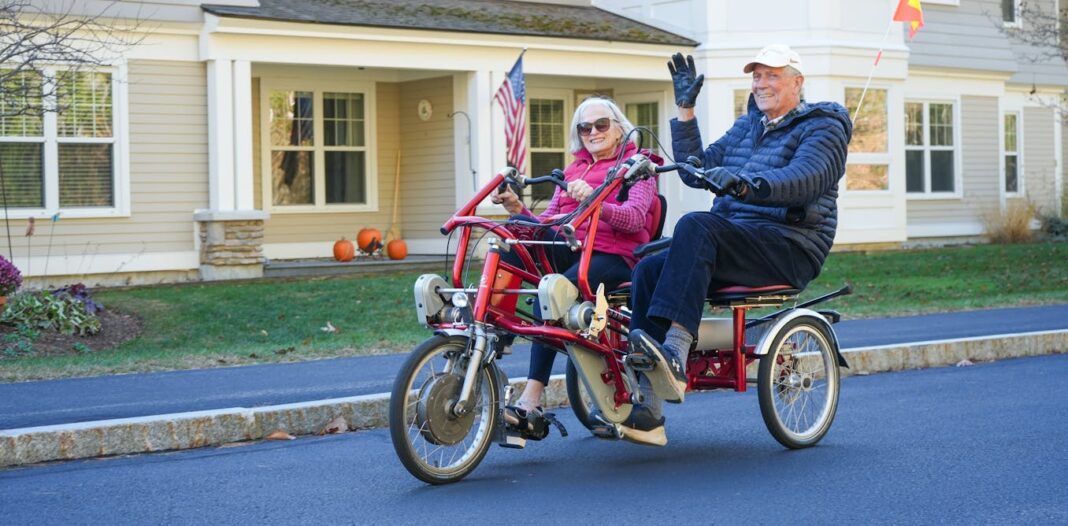Most Seniors Can Benefit from Cycling, but They Need Specialized Bikes and Infrastructure
Most senior citizens get around in their daily lives by driving, walking, or using public buses and subways. However, many people in their 60s and 70s could potentially be interested in other options, such as cycling. At a time when cycling is growing in the U.S. and the overall population is aging, seniors’ preferences for bike designs and bike networks are very relevant.
Older people may have concerns about riding a two-wheeled bike if they are afraid of falling – a risk that increases with age and causes many seniors to become less active. Many cities and communities are working to create safer bike networks, but these are designed for young, physically fit bikers who are less afraid to bike near cars and don’t need an occasional bathroom break.
As a researcher in architecture, with a focus on environment and behavior, and a senior, I have studied bikes and bike networks for over 43 years. In my latest project, I worked with a behavioral neurologist, a health and wellness coach who works with seniors, and a fitness director who also works with seniors, to learn from older people what kinds of bicycles and bike networks would help them stay active and independent through cycling.
Benefits of Biking for Seniors
Many older people in the U.S. don’t get enough physical activity for healthy aging. A 2016 study by the Centers for Disease Control and Prevention found that more than one-fourth of all adults over 50 did not engage in any physical activity outside of work. This share increased with age and was higher among people with chronic diseases such as cancer, diabetes, and depression. Inactivity was significantly higher among women than men, and among Black and Hispanic seniors compared with white seniors.
Biking provides many health benefits, including cardiovascular exercise, stronger muscles, better coordination, and lower stress levels. It also offers benefits that are particularly relevant for seniors. For example, one study found that cycling for at least one hour per week significantly improved older people’s balance, potentially making them less vulnerable to falls.
Senior-Friendly Bikes
For our study, we distributed surveys with pictures of senior-friendly bikes and questions about bike networks to 178 seniors in four senior communities in Massachusetts and New Hampshire. Participants ranked the pictures according to how well they liked the various bike designs and offered more comments while seeing the pictures on a large screen.
We also borrowed three senior-friendly bikes made by Van Raam, a Dutch company that designs bikes for a wide range of special needs. These models included:
- A three-wheeled bike for side-by-side riders who each have handlebars and who can pedal together while one steers.
- An adult tricycle with a back rest and low center of gravity.
- A two-wheeled bike with a low center bar that makes it easy to step through when getting on or off.
Fifty seniors at RiverWoods-Exeter, a senior living complex in New Hampshire, and Fox Hill Village, an independent living community for seniors in Westwood, Massachusetts, were invited to test-ride the three models and complete a survey about their experiences.
Designing Bike Networks for Older Riders
Based on photos, participants were most enthusiastic about the adult tricycle and also were interested in the two-seat three-wheeler. Adult tricycles are harder to pedal than bikes with two wheels, and rounding corners involves turning the handlebars without leaning, so these models have a learning curve. However, they offer stability, which clearly was important to the people in our study.
Among seniors who did test rides, the most popular model was the single-seat three-wheeled bike. Unlike a low recumbent bicycle, this bike’s seat is about as high as a chair, and unlike an adult tricycle, it has a back rest.
Conclusion
Our findings echo other studies that have shown that senior cyclists want to ride in protected bike lanes or separate paved paths rather than in street traffic. Because many seniors have limited vision, another feature that can make bike paths safer for them is light-colored demarcation strips at the edges of the path to help older riders avoid veering off the main cycle path, especially at night.
By understanding seniors’ preferences for bike designs and bike networks, we can develop scalable bicycling programs for seniors in the U.S. Some seniors might appreciate having classes to relearn how to ride a two-wheeled bike or to ride with another person on a two-seater model. Assisted living complexes could install bike storage sheds and buy several senior-friendly bikes for residents to ride.
FAQs
Q: What are the benefits of cycling for seniors?
A: Cycling provides many health benefits, including cardiovascular exercise, stronger muscles, better coordination, and lower stress levels. It also offers benefits that are particularly relevant for seniors, such as improved balance and reduced risk of falls.
Q: What kind of bikes are suitable for seniors?
A: Senior-friendly bikes are designed to be stable, easy to ride, and accessible. These bikes include three-wheeled bikes, adult tricycles, and two-wheeled bikes with low centers of gravity or back rests.
Q: What kind of bike networks are suitable for seniors?
A: Seniors want to ride in protected bike lanes or separate paved paths, with features such as light-colored demarcation strips, raised crosswalks, and nearby public bathrooms with signs leading to them.




